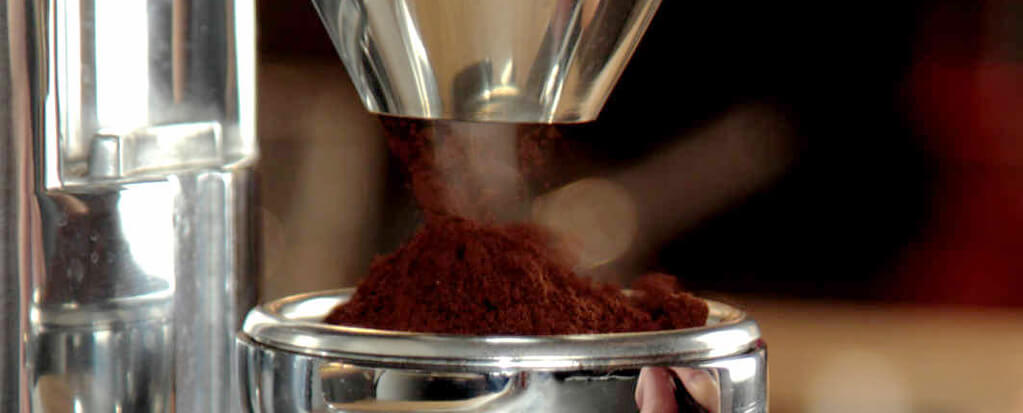Could not save your registration. Please try again.
Great, you are now registered. Welcome to the club and look forward to our updates.

For the best coffee enjoyment, a coffee grinder is just as important as the machine
A coffee grinder is at least as important for preparing good coffee as the espresso machine or brewing method. Coffee grinders are available for every application and in different price ranges. Here we describe the most important differences between espresso grinders, filter coffee grinders, conical and flat grinding discs, electrically operated and hand-operated grinders; because, freshly ground coffee tastes best.
A coffee grinder always consists of a grinding chamber in which a movable, adjustable grinder grinds coffee beans and discharges the resulting coffee grounds through an opening for use. The grinder is operated manually or electrically, and the necessary power is applied to the moving parts of the grinder via a shaft. These are the core elements of a grinder. The various coffee grinders differ in these features and thus determine where their strengths and weaknesses lie.
Coffee grinder types differ in the control of the motor running time and the presence of a dosing chamber. The motor running time can be controlled by a timer or a scale. With "grind on demand", the grinder grinds for a time predefined by the user and thus generates a relatively constant reference quantity. The disadvantage is that the grind must be adjusted after each change of grind. With "grind by weight", a load cell controls the motor running time. The user can set the desired amount of powder in grams and, depending on the quality of the system, receives a very constant and adequate amount â€" regardless of the grind, bean density or bean size. The disadvantage here is that the technology is not yet fully developed.
The dosing grinder (or espresso grinder) works in exactly the same way as an on-demand grinder. The only difference is that coffee is ground in an upstream dosing chamber from which it is dosed into the portafilter. This grinder is still the fastest way to obtain coffee powder. However, the ground coffee quickly loses its aroma if it remains in the container for longer. Opposite the espresso grinder is the shop grinder. It is characterised by its robust and simple design. An  "on/offÂ" button, a grinder regulator, an easily accessible bean feeder and, if necessary, a bag holder make up the shop grinder. The powerful motors and simplicity allow different (pre-portioned) coffees to be ground quickly, so the user can easily switch from the rare espresso to the exquisite filter and work with the same grinder. The disadvantage is the additional work steps (inserting beans each time, pre-portioning, re-weighing).
The two main players among the grinding discs are conical and flat grinding discs. In conical grinding discs, there is usually a central cone with sharp edges of different depths milled into it in a circumferential ring that has a similar tooth pattern. Together they form the grinding gap, the distance between the grinding discs, which together with the tooth depth determines the degree of grinding (i.e. the fineness of the coffee grounds). In most cases, the central, conical part rotates. There are a few, newer models where the outer ring rotates.
Flat grinding discs usually consist of very similar or even identical pairs of grinding discs. Two rings, where one is stationary and the other is rotating. The beans fall centrally into the grinding mechanism and are driven into the grinding gap. The distance between the two grinding discs and their tooth depth also determine the fineness here. Flat grinding discs can be arranged horizontally or vertically.
The performance of a mill depends on its motor and grinding disc. The motor drives the rotating grinding disc via a shaft. In the case of very hard beans (light roast, high density), the motor may not be able to apply the necessary torque and the mill may jam. The grinding disc and its rotational speed are decisive for the available grinding capacity (grams of coffee powder per second).
When buying a coffee grinder, there are three simple decisions to make beforehand. The following points will help you find the right grinder:
An espresso grinder can grind espresso and, if necessary, café crème. A coarser grind of filter coffee is not achieved with a classic espresso grinder, just as it usually cannot achieve the finer grind for Ibrik. A shop grinder, however, may be able to grind everything from espresso or even Ibrik to filter, but it is much more complicated to handle than an espresso grinder.
How much coffee should be prepared in what time with the grinder? A modern hand grinder can grind espresso and filter coffee, can be taken along on trips and costs much less than an electric grinder. However, if you make a lot of coffee and value convenience, a hand grinder is not recommended.
When choosing a coffee grinder for the home, café, office, restaurant or kiosk, it is important to consider not only the absolute amount of coffee consumed, but also its distribution over time. With a coffee grinder, it is the load peaks that give the machine trouble and subsequently also annoy the barista.
Make sure you plan your budget so that it is not just enough for a dream coffee machine. On the contrary: the quality of your coffee will thank you if you save on the espresso machine and buy a slightly more expensive grinder. However, your budget may have a significant influence on the above answers or limit your choices in advance.